Freshwater salmon fishing can be done from the shore or a boat, and many of the methods can be used either way. Boat fishing affords anglers some opportunities not available to shore anglers.
Drift fishing
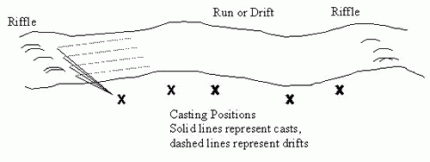
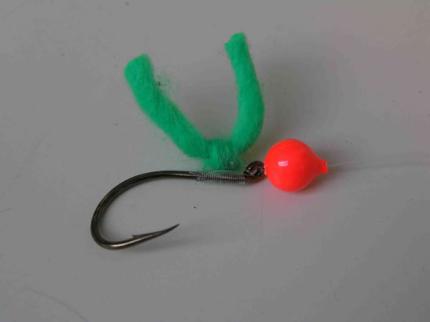
Drift fishing is a common method where the angler casts a line upstream, lets the line drift down through the run or pool, and then reels in the line to start the process over again. You can drift fish from the shore or an anchored boat. Generally, the idea is to weight your setup so it bounces along the bottom, touching every foot or so, at approximately the same speed the current is moving. More weight will slow down the speed at which your bait drifts downstream and less weight will speed up the drift. The usual strategy is to work the entire run from the shore closest to you to the shore furthest from you, and from the upstream end of the run (near the end of the riffle) to the downstream end of the run (near the start of the next riffle) (Figure 1). Under crowded conditions, you may simply have to work your way into a line of anglers and fish right where you are, without moving. Cast upstream at a 30-45 degree angle and let your bait bounce along until you reach a 45-30 degree angle downstream. Reel in and do it again. Your goal is to bounce your offering along the bottom until a fish picks it up with its mouth.
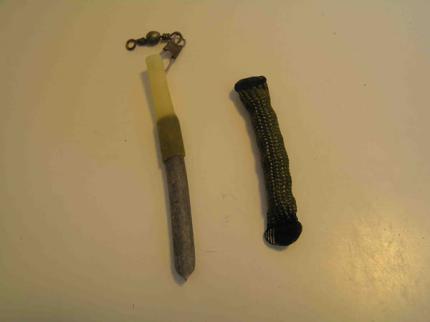
Novice anglers often have trouble telling when a fish has picked up the bait versus when their gear has caught on a rock. Over time, an angler develops a feel for the difference and learns when to set the hook and when to gently coax the gear off of the rocks.
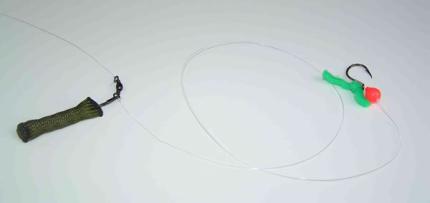
Typical drift fishing gear includes an 8 1/2- or 9-foot rod rated for 15-30 pound line, and either a bait casting reel or a spinning reel. For larger fish, like Chinook salmon, use 20-25 pound line. For smaller fish, like pink salmon, use 10-15 pound line. There are an endless variety of weights, lures, floats, and/or baits that anglers can use. A standard setup for salmon often consists of a snap swivel at the end of the mainline, a leader from 12-48” to a single hook with egg loop, a corky on the line above the hook, and yarn on the hook (Photo 1). For weight, push the snap swivel through a 3/4' long piece of rubber tubing and then push a “pencil” lead into the tubing, or simply push the snap through the parachute cord of a “slinky” weight (Photos 2 and 3). Bait and/or scent can be added to this rig. Salmon roe and sand shrimp are the most popular baits to add to this setup, but many others can also be used. Instead of a corky and yarn setup, you can also substitute a winged bobber (Photo 4) or other drift bobbers, for the corky, or just fish bait alone. The weight and corky setup can also be removed and you can drift with spoons or spinners, bouncing them along the bottom and slowly retrieving them.
Plunking
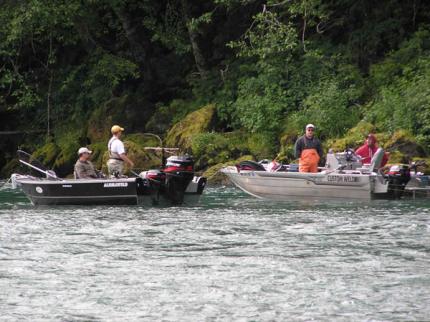
Plunking employs a similar setup to drift fishing, except that the gear is cast into a likely holding area or migratory path, and allowed to anchor in one spot (Photo 5). The gear is then left alone until a fish strikes, or you decide to change gear. Active lures such as winged bobbers, spoon, spinners, or kwikfish are often used when plunking in current. Plunking can be done from shore or an anchored boat.
A very popular lure on the Columbia River is a kwikfish wrapped with a small filet of sardine or other fish (Photo 6). Use an 8 1/2- to 9-foot extra-heavy rod. Your mainline should be 40-60 pound monofilament or spectra. At the end of your mainline, slip your line through the end of a swivel or slider, add 4-6 beads, and then tie to a swivel. Tie 4-6 feet of 40-60 pound monofilament leader to the other end of the swivel and then directly to the duo-lock snap on the kwikfish. Tie an 18-30” piece of 15 pound leader to the slider (or swivel that you ran the mainline through) and attach 1-8 ounces of lead. Most salmon anglers use sizes K13 to K16. Use the larger sizes in slow water and the smaller sizes in faster water.
Be sure to tune your kwikfish so that it tracks straight when you pull it upstream through the water. If it dives to the left, turn the screw eye clockwise. If it dives to the right, turn the screw eye counter-clockwise. Back the kwikfish downstream until the weight is firmly settled in place on the bottom and the kwikfish is still wobbling from side to side. Put your rod in a rod holder and don’t try to set the hook when a fish first hits. Let the fish pull the rod down to water level at least 3 times before trying to reel it in.
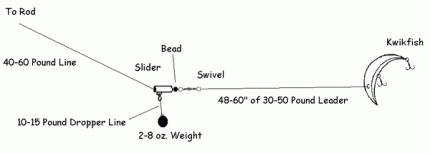
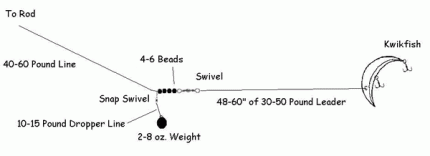
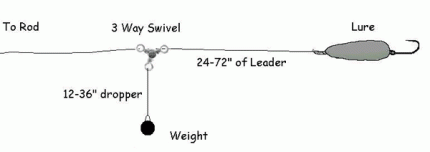
Thin bladed spoons can be plunked on lighter, or medium action, rods in smaller rivers or slower water (see Photo 7 and Photo 8). The size of the spoon is matched to the depth and current speed where it will be fishing. They can be fished with weight and a dropper if necessary, or you can just “flatline” them in shallow water, that is, fish them without any added weight. Thin bladed spoons should be let out behind your boat until you reach the desired location, generally in 4-5 feet of water on the upstream side of a riffle. These spoons work best on lighter lines, around 15 pound test, and if you are fishing without weight, they work best when the line has a belly in it between the water and the tip of rod. Spoons are very effective on pink and coho salmon. Use smaller spoons (1/2 – 1 1/2”) in pink, white, red, cerise, or combinations for pink salmon. For coho use medium size spoons (2 - 3”) with silver or brass blades that can also be painted. Popular colors are chartreuse, fluorescent pink, and fluorescent orange.
Where in a river to set your gear is a critical element of plunking. On larger rivers, try to set up on an inside curve where any fish migrating up that side have are forced around the point. In smaller rivers, look for tail-outs just upstream of riffles. These are areas that fish will rest in after swimming through the riffles. At low flows in small rivers, stay towards the main current, and look for areas where the current starts to slack up a bit. In larger rivers, or small rivers at high flows, work the edges where the current isn’t too fast. Remember that upstream migrating salmon are looking for the easiest route up the river that offers enough cover that they feel safe from predators. That cover may be deep water, logs, boulders, a bubble curtain, or even the white water in a riffle.
Bobber or Float Fishing
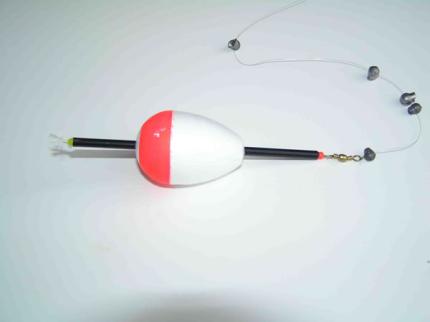
Bobber or float fishing is often used in situations where water is very slow moving or even stationary, such as in a big eddy or tidewater at slack tide. Rods of 10-12’ are not uncommon for float fishing. Spectra lines are desirable because they don’t stretch and they float. To rig for float fishing, use a sliding float (Photo 9), a swivel, some weight to pull the line through the float, and a 12-24” leader to a bait or lure. A “bobber stop” and small bead are used to set the float at the depth you wish to fish. The bobber stop can be reeled through the rod guides if necessary for easier casting. Bobber stops can be purchased pre-tied, or you can tie your own with 15-30# Dacron using a uni-knot. Very early in the morning, you might find fish suspended off the bottom and will want to set your bobber stop so that your gear is at the depth you think fish are suspended at. Once the sun hits the water, salmon tend to move to the bottom and you should adjust your bobber stop so that your bait or lure is within a foot of the bottom. Serious bobber anglers use a longer rod than drifters or trollers, and switch their mainline to a no-stretch Spectra based line. (See diagram of a common slip bobber set up)
When fishing in current, you will need to “mend” the line occasionally. Mending generally means lifting and/or flipping the line so that any belly is removed and the line is then in a straight line between the rod and bobber. The line needs to be mended to ensure a good hookset if the bobber goes down. Spectra based lines float and are therefore easier to mend, and their lack of stretch ensures that all of the hookset is transmitted to the bait or lure. Salmon eggs are the top choice for bait, although sand shrimp are very popular for chinook salmon. Some anglers like to fish both at the same time. Marabou jigs (Photo 10) can be used instead of bait and can be especially effective on pink salmon, or other salmon when the water is very low and clear.
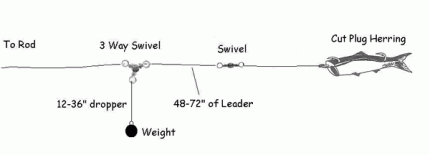
Trolling
Trolling consists of fishing out of a constantly moving boat. Trollers will use weights, divers, or downriggers to achieve a desired depth to present their bait or lures. Freshwater trolling for salmon is conducted primarily in the lower ends of larger rivers, such as the Columbia River, where incoming tides cause river flows to slow down or even reverse such that the flow is upstream. The standard drift fishing rod equipped with 20-25 pound line can be used for river or bay salmon trolling. Trolling setups are usually comprised of a three-way swivel at the end of the mainline, a 12-36” dropper line and weight off the center of the three way swivel, and a 4-8’ foot leader with twin hooks and a cut plug herring or lure.
Instead of a cutplug herring, you can also troll spinners (Photo 11), plugs (Photo 12), kwikfish, or bait harnesses (Photo 13).
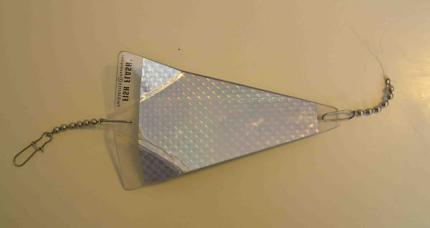
Weights are usually 2-8 ounces depending on the speed of the current and boat. The dropper line used for the weight is usually lighter than the mainline so that the dropper breaks before the mainline if the weight becomes snagged. Many anglers now use an in-line rotating flasher along with their herring (Photo 14).
Rig the in-line flasher between the three-way swivel and the herring, ensuring that the distance from the swivel to the flasher is longer than the distance of the weight dropper line.
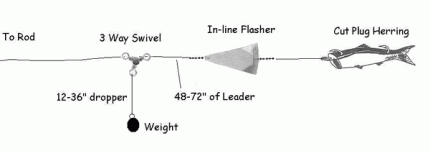
When fishing for spring chinook, try to stay near the bottom, bouncing your weight often. Fish at the depth your fish finder shows fish for fall Chinook and coho. Bottom is always a good bet for Chinook. For coho, you may not even need weight for your lures and can sometimes find fish quite close to the surface. Trolling can also be effective in estuaries such as the mouth of the Columbia River (Buoy 10), Willapa Bay, or Grays Harbor, and in extreme terminal marine areas such as the mouth of the Nisqually River.